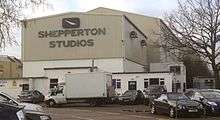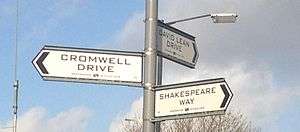Shepperton Studios
 | |
| Subsidiary | |
| Industry | Film Television |
| Genre | Film Studio |
| Founded | 1931 |
| Headquarters | Shepperton, Surrey, England, UK |
| Owner | The Pinewood Studios Group. |
| Parent | The Pinewood Studios Group. |
| Website |
www |
Shepperton Studios is a film studio located in Shepperton, Surrey, England with a history dating back to 1931. It is now part of the Pinewood Studios Group. During its early existence the studio was branded as Sound City.
History
1930s–1960s
Before Shepperton Studios was built, there was Littleton Park, which was built in the 17th century by local nobleman Thomas Wood. The old mansion still stands on the site.
Scottish businessman Norman Loudon purchased Littleton Park in 1931 for use by his new film company, Sound Film Producing & Recording Studios; the facility opened in 1932. The studios, which produced both short and feature films, quickly became successful and expanded rapidly. Proximity to the Vickers-Armstrongs aircraft factory at Brooklands, which attracted German bombers, disrupted filming during the Second World War, as did the requisitioning of the studios in 1941 by the government, who first used it for sugar storage and later to create decoy aircraft and munitions for positioning in the Middle East. The Ministry of Aircraft Production also took over part of the studios for the production of Vickers Wellington bomber components early in the war.
After re-opening in 1945, the studios changed hands. When Sir Alexander Korda purchased British Lion Films, he also acquired a controlling interest in Sound City and Shepperton Studios. Among the films in which he was involved during this period were The Fallen Idol (1948) and The Third Man (1949) which was shot both at the studios and on location and has been referred to as the best British film noir.[1]
In spite of such successes, British Lion ran into financial difficulties in the 1950s when it was unable to repay a 1949 loan from the National Film Finance Corporation and went into receivership on 1 July 1954.[2] In January 1955, a new company, British Lion Films Ltd, was formed and Roy and John Boulting took over at Shepperton Studios. Their comedies, such as I'm All Right Jack (1959), were produced there, as were dramas from other film-makers such as J. Lee Thompson's The Guns of Navarone (1961). The studio's other projects from the same decade include Stanley Kubrick's Dr Strangelove (1964)[3] and the musical Oliver! (1968), which won the Sound Department's Academy Award.[4]
1970s to the present

Despite the financial ups and downs of British Lion and the changing of hands, the studios remained active until the early 1970s. In 1969, the studios produced 27 films; by 1971 this number had fallen to seven. Production throughout the 1970s was erratic, reaching a low of two films by 1979. Among the problems faced by Shepperton Studios during this time was the desire of new British Lion director John Bentley to sell the grounds for housing, since re-purposing the land would have nearly doubled its value. A compromise was proposed, and in 1973 the area of the studios was reduced from 60 acres (240,000 m2) to 20 acres (81,000 m2).
The studios' 1970s credits include Kubrick's A Clockwork Orange and Jimmy Perry and David Croft's Dad's Army (1971), Richard Attenborough's Young Winston (1972) and Fred Zinnemann's The Day of the Jackal. In 1975, the studios were again transferred to new ownership and in spite of sparse production schedules served as the filming site of some high-budget productions, including Richard Donner's The Omen (1976), Franklin Schaffner's The Boys from Brazil (1978), Ridley Scott's Alien (1979), David Lynch's The Elephant Man (1980), Attenborough's Gandhi (1982) and David Lean's A Passage to India (1984). In 1978, rock band The Who filmed live concert scenes at Shepperton especially for their documentary The Kids Are Alright.
In 1984, Shepperton Studios changed hands yet again, coming under the control of brothers John and Benny Lee, who renovated the studios but soon lost control as a result of the "Black Monday" of 1987, the 1988 Writers Guild of America strike and internal issues within their company, Lee International. Bankers Warburg Pincus acquired the studios, which became busy with the filming of TV shows as well as such films as Franco Zeffirelli's Hamlet (1990), Kevin Reynolds' Robin Hood: Prince of Thieves (1991) and Nicholas Hytner's The Madness of King George (1994). In 1995, the studios were purchased by a consortium headed by Ridley and Tony Scott, which led to an extensive renovation of the studios as well as the expansion and improvement of its grounds.
In 2001, Shepperton Studios underwent another merger to form part of the Pinewood Studios Group, which also owns Pinewood and Teddington Studios in the UK, as well as Pinewood Studio Berlin in Germany, Pinewood Toronto Studios in Canada, Pinewood Indomina Studios in the Dominican Republic and Pinewood Iskandar Malaysia Studios in Malaysia.
Stages and locations
Shepperton Studios has 15 stages, ranging in size from 3,000 square feet (280 m2) to 30,000 square feet (2,800 m2), five of which are equipped with interior tanks for water and underwater filming. Although often described as the home of independent film and TV production in the UK, the studios have also served as a production base for high-budget films such as Captain America: The First Avenger (2011), the filming for which used eight of the fifteen stages. The children's TV series Thomas the Tank Engine & Friends was shot on the "T Stage" from 1984 to 2008, after which the live action models originally used were replaced with computer animation.
The nearby Little House and surrounding grounds have been used as a filming location for films such as The Omen (1976) and The Young Victoria (2009). The studios also have two large backlots, which have recently been used to create two castle compounds for the film 47 Ronin.
Selected film credits
Many films have used Shepperton Studios, including (in date order):
- The Fallen Idol (1948)
- The Third Man (1949)
- The Holly and the Ivy (1952)
- An Inspector Calls (1954)
- Richard III (1955)
- Mysterious Island (1961)
- Lawrence of Arabia (1962)
- Dr. Strangelove (1964)
- Becket (1964)
- Georgy Girl (1966)
- 2001: A Space Odyssey (1968)
- Oliver! (1968)
- Scrooge (1970)
- Dad's Army (1971)
- Young Winston (1972)
- Psychomania (1973)
- The Omen (1976)
- Star Wars (1977)
- The Boys from Brazil (1978)
- Superman (1978)
- Alien (1979)
- The Elephant Man (1980)
- Flash Gordon (1980)
- Saturn 3 (1980)
- Blade Runner (1982)
- Gandhi (1982)
- A Passage to India (1984)
- Out of Africa (1985)
- The Princess Bride (1987)
- Henry V (1989)
- Hamlet (1990)
- Robin Hood: Prince of Thieves (1991)
- Chaplin (1992)
- The Muppets Christmas Carol (1992)
- Four Weddings and a Funeral (1994)
- The Madness of King George (1994)
- Judge Dredd (1995)
- Sense and Sensibility (1995)
- Muppet Treasure Island (1996)
- The Wind in the Willows (1996)
- Evita (1996)
- 101 Dalmatians (1996)
- G.I. Jane (1997)
- Lost in Space (1998)
- Shakespeare in Love (1998)
- The Mummy (1999)
- Notting Hill (1999)
- Sleepy Hollow (1999)
- Billy Elliot (2000)
- Chocolat (2000)
- Gladiator (2000)
- Bridget Jones's Diary (2001)
- Gosford Park (2001)
- Spy Game (2001)
- About a Boy (2002)
- Bend It Like Beckham (2002)
- Love Actually (2003)
- Alexander (2004)
- Harry Potter and the Prisoner of Azkaban (2004)
- Troy (2004)
- Wimbledon (2004)
- Batman Begins (2005)
- Harry Potter and the Goblet of Fire (2005)
- Sahara (2005)
- Star Wars: Episode III – Revenge of the Sith (2005)
- The Da Vinci Code (2006)
- Atonement (2007)
- Elizabeth: The Golden Age (2007)
- The Golden Compass (2007)
- Inkheart (2009)
- Moon (2009)
- Nine (2009)
- The Young Victoria (2009)
- Clash of the Titans (2010)
- Robin Hood (2010)
- Captain America: The First Avenger (2011)
- Hugo (2011)
- Anna Karenina (2012)[5]
- John Carter (2012)
- Fast & Furious 6 (2013)
- Gravity (2013)
- Jack the Giant Slayer (2013)
- Thor: The Dark World (2013)
- Guardians of the Galaxy (2014)
- Into the Woods (2014)
- Avengers: Age of Ultron (2015)
- Victor Frankenstein (2015)
- Alice Through the Looking Glass (2016)
- Doctor Strange (2016)
- Patient Zero (2016)
- Beauty and the Beast (2017)
Selected television credits
- Thomas the Tank Engine & Friends (1986–2008)
- TUGS (1988–1990)
- Red Dwarf (1991–99; 2009; 2012)
- Rebecca (1997)
- Dancing on Ice (2011)
- The Crystal Maze (1990)
- Russell Howard's Good News (2014)
- You Bet! (1988–1997)
References
- ↑ See for example Malcolm, Derek (16 March 2000). "Carol Reed: The Third Man". The Guardian.
The Third Man... [Carol Reed's] second collaboration with Graham Greene, is probably the best film noir ever made out of Britain.
; reprinted in Derek Malcolm A Century of Films, London & New York: I.B Tauris, 2000, p.51-53, 51 - ↑ The Times, 2 June 1954, page 6: Receiver for British Lion Film Corporation – found in the Times Digital Archive (subscription required) 2014-07-25
- ↑ the casting credits after the film indicate the studio.
- ↑ "The 41st Academy Awards (1969) Nominees and Winners". oscars.org. Retrieved 2011-08-25.
- ↑ "Keira Knightley ambitious visual experience for 'Karenina'". azcentral.com. Retrieved 2012-06-20.
External links
Coordinates: 51°24′24.80″N 0°27′54.65″W / 51.4068889°N 0.4651806°W
